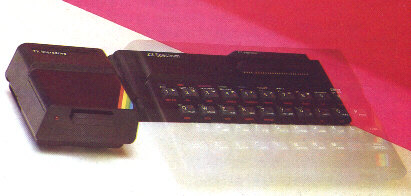Loop The Loop The Sinclair concept of low-cost, high-power computing was achieved with the immensely popular Spectrum home computer, but this micro lacked a large-capacity, fast-access storage device until Sinclair introduced the Microdrive. It costs less than £80 and comes complete with its own interface.
The Microdrive system uses a continuous 200in loop of 2mm magnetic video tape that revolves inside a small cartridge once every seven seconds. Although accessed and instructed in much the same way as a standard floppy disk drive, it is actually a ‘floppy tape’ or ‘stringy floppy’. Data is recorded digitally, as opposed to the audio tape method, which records tones. The video tape is formatted into two tracks in which data bits are recorded sequentially in an overlapping zig-zag pattern. This system, which requires two read/write heads, enables data to be stored at double the density and speed of a single-track system. The tracks are further formatted into blocks of 512 bytes. Each block contains a description of the data contained within it and is preceded by a ‘header’ consisting of 27 bytes of identifying data. A block and its associated header are known as a sector, The 200in tape loop can store almost 200 sectors, giving a data storage density of approximately 500 bytes per inch. A file identified with a file name is stored in a single sector if it is less than 512 bytes in length. If ft overlaps into another sector, or several, without filling the final sector, the unused sector space is lost until the file is erased. So although each Microdrive can theoretically store 100 Kbytes of data, its capacity is in reality between 85 and 90 Kbytes. Average access time to find and load a program into Spectrum memory is between 10 and 15 seconds. THE ZX INTERFACE The Microdrive is connected to the Spectrum via a ZX Interface 1, which is attached to the micro’s peripheral edge connector. Up to eight Microdrives can be connected one to another in a ‘daisy chain’ arrangement. In addition to providing a connection for Microdrives the Interface I serves as a standard RS232 interface, a local area network interface and a ZX Printer connector. It also contains instructions within ROM that extend Sinclair BASIC to include suitable data handling commands for the Microdrive and other interfaces. The ZX Microdrive and the Interface I are powerful additions to the Spectrum system. The facilities offered closely simulate the operation of a conventional floppy disk system. However, limitations are imposed by the dubious long-term reliability of the tape cartridges and the lack of a true random access file facility. This affects the viability of the Microdrive as a storage system for serious business applications, for most commercial software demands the location, storage and retrieval of small amounts of data many times during use. Moreover, little software recorded on Microdrive cartridge is available at present, although this is likely to change dramatically in the near future. The advent of the Sinclair QL business computer, supplied with two built-in Microdrives, may well bring about an extension of the capabilities of the system. If Microdrives prove their reliability they will be of enormous value to the Spectrum owner who requires simply the facility to store large amounts of data and retrieve it quickly. |
| [ Main Page ] [ Features ] |
